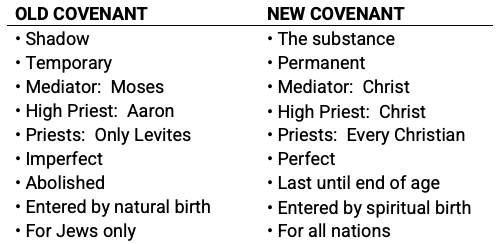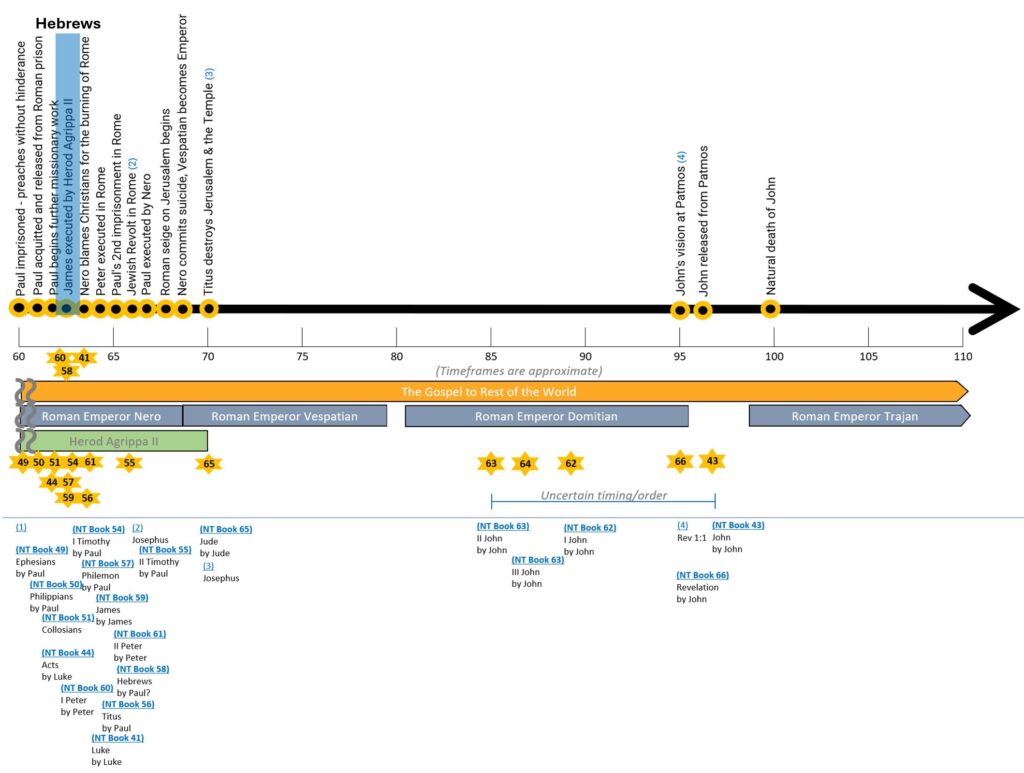Hebrews
The Superiority of Jesus Christ
Summary | About | Why You Should Read it | Author | When Written | Context | Timeline | Location | Outline | Observations | Resources
Summary
Hebrews is written to believers that came from a Jewish background and still live in a Jewish culture. The author of Hebrews had three main objectives: 1) Help the believers combat apostasy (Heb 2:1-4; 10:19-25); 2) Encourage them to persist to spiritual maturity (Heb 5:11-14; 0:32-39); and, 3) Give them comfort in their persecutions (Heb 11:1-12:3). It is addressed to Jewish believers to help them understand from their old covenant perspective how Jesus Christ has fulfilled that covenant and has given them a new one.
The next table is a high-level look at the structure and contents of Hebrews.

About
Hebrews is the 19th book of the New Testament and most likely the 14th book authored by Paul (in biblical order, not chronological order).

Why You Should Read It
The Book of Hebrews is written to Christian believers in danger of falling away. As such, Hebrews addresses the Jewish dilemma of having been under the law and no longer being so, and dealing with the persecution from both traditional Jewish followers and the Roman authorities. In so doing it specifically addresses 5 warnings we should be aware of in our daily walk. These warnings are:
- The Danger of Drifting Hebrews 2:1-4
- The Danger of Disobedience Hebrews 3:7-4:13
- Progress toward Maturity Hebrews 5:11-6:20
- The Danger of Willful Sin Hebrews 10:26-39
- Warning against Indifference Hebrews 12:25-29
It also addresses the common misconception among many denominational churches centered around what is referred to as “Replacement Theology”, in which it is wrongly believed that the promises God gave to the Jews fall to the Church because they rejected God. This is addressed specifically in Chapters 9-11 that deal with topic of Israel’s past, present (at the time) and future.
The following tables draws a comparison the author makes between the old covenant and the new covenant.

Author
The authorship of the Book of Hebrews has been a topic of debate among Christian scholars for centuries. Unlike other New Testament books, Hebrews does not explicitly state who its author is, leading to various theories. Below are the most prominent theories and the reasoning behind them according to some of the best Christian scholars:
1. Pauline Authorship
- Proponents: Early Church Fathers like Clement of Alexandria and Origen suggested Paul as the author.
- Reasoning:
- Similar theological themes: There are theological similarities between Hebrews and Paul’s epistles, such as the emphasis on faith, the priesthood of Christ, and the New Covenant.
- Association with Timothy: Hebrews 13:23 mentions Timothy, a close associate of Paul, suggesting a link.
- Romans, Galatians and Hebrews combine to make a trilogy relating to the book of Habakkuk 2:4, “The just shall live by faith.” Romans explains why, Galatians explains what it means to live by it and Hebrews explains what faith is and means.
- Counterarguments:
- The writing style and vocabulary differ significantly from Paul’s other letters.
- Hebrews does not include Paul’s typical greeting or self-identification.
2. Barnabas
- Proponents: Tertullian, an early Church Father, argued for Barnabas.
- Reasoning:
- Barnabas was a Levite, and Hebrews has a strong focus on the Levitical priesthood and Jewish rituals, suggesting someone with an intimate knowledge of Jewish practices.
- Barnabas was a close companion of Paul, which could explain some of the theological overlap.
3. Apollos
- Proponents: Martin Luther was one of the first to suggest Apollos as the author.
- Reasoning:
- Apollos was known to be eloquent and knowledgeable about the Scriptures (Acts 18:24), matching the sophisticated Greek and deep Old Testament knowledge found in Hebrews.
- He was associated with Alexandria, where allegorical interpretation was popular, similar to the style seen in Hebrews.
4. Priscilla (and Aquila)
- Proponents: This theory was suggested by Adolf von Harnack.
- Reasoning:
- Priscilla was a prominent teacher in the early church (Acts 18:26), and her authorship could explain why the book’s author remains anonymous—perhaps due to her being a woman in a male-dominated culture.
- The collaborative nature of the ministry of Priscilla and Aquila could explain the plural references and personal nature.
LearningGod.Org Conclusion
Based on a number of clues contained in the writings of the New Testament, the conclusion we have come to is that Hebrews was written by Paul. Although Paul did not identify himself, as he did in all of his other letters, he had a very good reason not to. He wrote Hebrews to stand on its its own based on the Old Testament scriptures so that his authorship could not be called into question. It doesn’t matter who wrote it from this perspective. What matters is what it says.
When Written
Hebrews must have been written before the destruction of Jerusalem and the temple in a.d. 70 because: (1) If it had been written after this date, the author surely would have mentioned the temple’s destruction and the end of the Jewish sacrificial system; and (2) the author consistently uses the Greek present tense when speaking of the temple and the priestly activities connected with it (see 5:1-3; 7:23,27; 8:3-5; 9:6-9,13,25; 10:1,3-4,8,11; 13:10-11).
Context
The Book of Hebrews was written at a time shortly before the fall of Jerusalem and the destruction of the temple. In this period, the Romans were threatening the Jews and the followers of the Way (Christians) with more dominant rule, as. The Jews rebelled against their authority. It was in the early 60’s A.D. that the Christians were blamed for the burning of Rome and both Jews and Christians were heavily persecuted.
While both the Jews and Christians faced Roman persecution, the Christians also faced religious persecution from the Jews. It was written to Jewish believers who were being pressured to return to the traditions of their fathers and the Mosaic Law. There was a strong temptation for apostacy, as it was safer and more socially acceptable and would alleviate persecution. Hebrews addresses this temptation by urging steadfastness in the Christian faith.
The Christian community was also dealing with social isolation, being viewed with suspicion both by fellow Jews who saw them as heretics and by Gentiles who misunderstood their practices.
Timeline
The general order of events from the New Testament period of the early 60s to the early 100s is shown below. This letter was written in this timeframe.
Location
It is addressed to a Christian community of considerable size (Heb 13:34); therefore, we assume it was first delivered to Jerusalem (Acts 11:23) or the churches of Judea (Acts 9:31). It was written by someone who had been in bonds (Heb 10:34) and who had been separated from the Jewish believers (Heb 13:19). That is why most scholars believe it was written by Paul when he was in the hired house in Rome (Acts 28:30).
Outline
Prologue: The Superiority of God’s New Revelation (1:1-4)
The Superiority of Christ to Leading Figures under the Old Covenant (1:5; 7:28)
Christ Is Superior to the Angels (1:5; 2:18)
Scriptural proof of his superiority (1:5-14)
Exhortation not to ignore the revelation of God in his Son (2:1-4)
Jesus was made a little lower than the angels (2:5-9)
Having been made like us, Jesus was enabled to save us (2:10-18)
Christ Is Superior to Moses (3:1; 4:13)
Demonstration of Christ’s superiority (3:1-6)
Exhortation to enter salvation-rest (3:7; 4:13)
Christ Is Superior to the Aaronic Priests (4:14; 7:28)
Jesus is the great high priest (4:14-16)
Qualifications of a priest (5:1-10)
Exhortation to press on toward maturity (5:11; 6:12)
The certainty of God’s promise (6:13-20)
Christ’s superior priestly order (ch. 7)
The Superior Sacrificial Work of Our High Priest (8:1; 10:18)
A New Sanctuary and a New Covenant (ch. 8)
The Old Sanctuary (9:1-10)
The Better Sacrifice (9:11; 10:18)
A Call to Follow Jesus Faithfully and with Perseverance (10:19; 12:29)
Having Confidence to Enter the Sanctuary (10:19-25)
A Warning against Persistence in Sin (10:26-31)
Persevering in Faith under Pressure (10:32; 12:3)
As in the past, so in the future (10:32-39)
Faith and its many outstanding examples (ch. 11)
Jesus, the supreme example (12:1-3)
Encouragement to Persevere in the Face of Hardship (12:4-13)
Exhortation to Holy Living (12:14-17)
Crowning Motivation and Warning (12:18-29)
Conclusion (ch.13)
Rules for Christian Living (13:1- 17)
Request for Prayer (13:18-19)
Benediction (13:20-21)
Personal Remarks (13:22-23)
Greetings and Final Benediction (13:24-25)
Observations
- Many regard the Book of Hebrews as the 14th epistle of Paul.
- The 3rd century theologian, Origen wrote: “Who it was that really wrote the epistle (Hebrews), God only knows.”
- The Book of Hebrews shows the superiority of Christianity over the Judaic system under the Law of Moses.
- A majority view seems to be that the recipients of Hebrews probably lived in Rome. Hebrews 13:24 – “Those from Italy greet you.”
- The recipients of the Book of Hebrews:
- had become Christians by hearing the preaching of those who had been eyewitnesses of Christ. 2:3
- Were not recent converts (novices). 5:12
- Had become “Dull of hearing” (5:11) and were in danger of drifting away from Christ.
- There are nearly 100 Old testament references in the Book of Hebrews, all of which are from the Septuagint version.
- Exodus and Leviticus are especially helpful in understanding Hebrews.
- Prominent words in the Book of Hebrews include:
- “Better”
- “Heavenly”
- “Perfect”
- “By faith”
- The basic theme of Hebrews is found in the word “better,” in describing the superiority of Christ in both His person and His work. Christ provides:
- Better revelation. 1:1-2
- Better expectation. 6:9
- Better priesthood. 7:7-11, 20-28
- Better hope. 7:19
- Better testament, covenant. 7:22, 8:6
- Better promises. 8:6
- Better sacrifices. 8:6
- Better possessions. 10:34
- Better country. 11:16
- Better resurrection. 11;35
- Better things. 11:40; 12:24
- In his Person, Christ is better than:
- The angels
- Moses
- Joshua
- In His Performance, Christ provides:
- A better priesthood
- A better sanctuary
- A better covenant
- A better sacrifice
Sections in Hebrews
- Jesus Christ is superior in His person 1:1-4:13
- Jesus Christ is superior as our priest 4:14-10:18
- Jesus Christ is superior for life 10:19-13:25
Theme
- The writer (believed to be Paul) focuses on how Jesus is a better way than the old Mosaic covenant and how Jesus fulfilled that covenant.
- This was written to the believing Jews who were considering going back to the law to avoid persecution.
- It focuses on the absolute superiority of Jesus Christ.
Jesus in Hebrews
- Jesus is the absolutely superior revelation of God and our eternal High Priest (1:1-14; 3:1).
Old Testament
New Testament
Free Resources
Other Resources
- x


